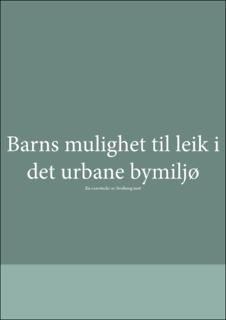| dc.description.abstract | Verdas befolkning aukar stadig, spesielt i byane. Det gjer også at andel barn i by også aukar. Ein konsekvens av dette er at folk bur meir tett og tilgangen til opne areal blir færre. Areal som tidlegare har vert mykje brukt av barn og unge i leik og rekreasjon. For barn som bur i by er dei urbane rom ein del av deira oppvekstmiljø.
For barn i by blir dei offentlege urbane byrom ein sentral del av deira oppvekstmiljø. Leik er viktig for barn, ikkje berre fordi det gir mykje glede – men fordi det gir eit grunnlag for allsidig utvikling. Med allsidig utvikling meinar ein utvikling av mellom anna det kognitive, mentale, fysiske og sosiale. Det er gjennom leik barn utviklar mange sider ved seg sjølv. Derfor må byplanlegging gå i dialog med pedagogiske prinsipp for å kunne møte denne gruppa sine behov for vekst og utvikling.
Denne oppgåva ser på korleis dei urbane byromma i Storhaug aust bidrar til gode oppvekstmiljø der ein ser på ulike pedagogiske kvalitetar. Gjennom fleire rundar med observasjon er det mykje som tydar på fråvær av slike kvalitetar som blir sett på som viktige for gode nærmiljø.
Måten bydelen er designa på gir ikkje den variasjonen som verken barn og unge har behov for, og ei heller for den variasjon ein by trenger for at det gir liv og aktivitet og ei heller klarar å møte behov til andre grupper. | |
| dc.description.abstract | The world's population is constantly increasing, especially in cities, which also means that the proportion of children in cities also increase. One consequence of this is that people are living closer together and access to open space is becoming less available. Areas that were previously used extensively by children and young people for play and recreation. For children who are living in cities, urban spaces are a part of their environment for growth and development.
For children in cities, public urban spaces are a central part of their environment for growth and development. Play is important for children, not only because it brings a lot of joy, but because it provides a basis for versatile development. Versatile development means development of, among other things, cognitive, mental, physical and social skills. It is through play that children develop many aspects of themselves. Therefore, urban planning must be in dialogue with educational principles in order to meet the needs of this group for growth and development.
This assignment looks at how the urban spaces in Storhaug east contribute to good environments for growth and development, looking at various educational qualities. Through several rounds of observation, there is much to suggest the absence of such qualities that are seen as important for good local environments.
The way the district is designed does not provide the variation that neither children nor young people need, nor the variation that a city needs in order to provide life and activity, and also fails to meet the needs of other groups. | |
